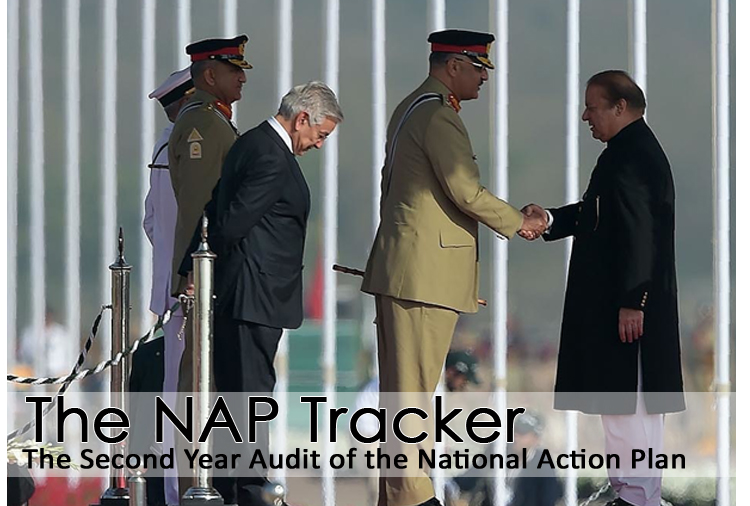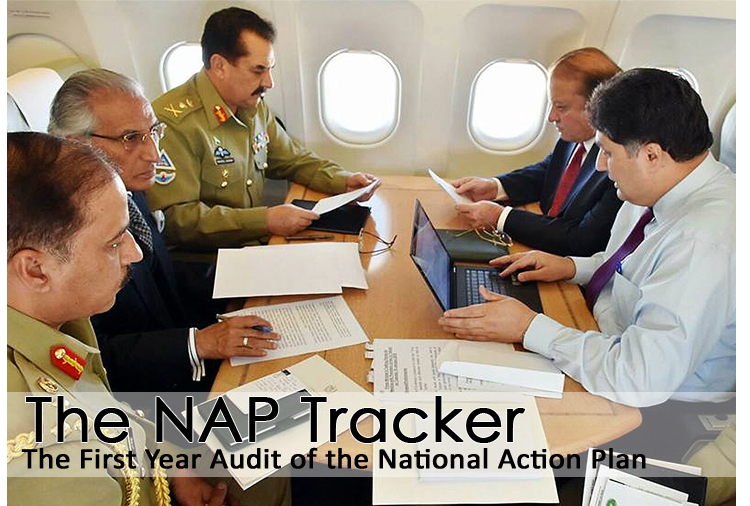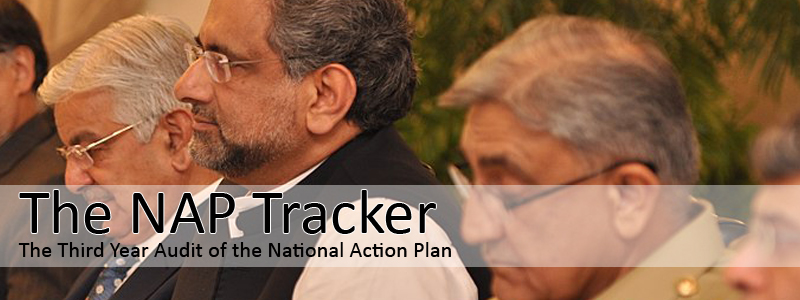The NAP Tracker is the only publication of its kind that tracks the Pakistani state’s progress on all 20 points of the National Action Plan. Please see the full PDF of Year 3 here.
The third year of the National Action Plan (NAP) witnessed a small set of victories and significant stagnation and setbacks. Perhaps the most telling piece of evidence was the National Security Council (NSC) meeting conducted with civil and military heads on December 19, 2017, three days after the third anniversary of the Army Public School attack in Peshawar that birthed the NAP. The meeting, chaired by Prime Minister Shahid Khaqan Abbasi, was attended by Interior Minister Ahsan Iqbal, National Security Adviser retired Lt Gen Nasser Khan Janjua, Chairman Joint Chiefs of Staff Committee Gen Zubair Mehmood Hayat, Army Chief Gen Qamar Javed Bajwa, Naval Chief Admiral Zafar Mahmood Abbasi, Air Chief Marshal Sohail Aman and senior officials. The most significant takeaway was that everyone felt NAP needed more work.
As has been the case in the last two years of the NAP’s implementation, Pakistan’s mechanisms and interventions for dealing with the root cause of extremism remain largely ineffective. It was hoped that with victories on the kinetic front, there would be a shift on the ideological side. It is hoped that in the coming year, the softer side of NAP will also receive an overhaul and there will be a shift in focus on thought on the elements that drive radical thought.
Please see the full PDF of Year 3 here.
The NAP Tracker – The Second Year
 On December 16, 2014, armed militants broke into the Army Public School (APS) in Peshawar Cantonment area of the Khyber Pukhtunkhwa (KP) province. In the brazen attack, they murdered 133 schoolchildren, as well as 10 teachers, including the principal. This atrocious attack was a major paradigm shift in Pakistan, and will forever remain the incident that damaged and radically altered our collective national psyche. On December 25, 2014, the National Action Plan (NAP) was enacted. This was established by the state to crack down on terrorism and to supplement an-terrorist offensives. It is a major coordinated state retaliation following the deadly Peshawar school attack but has since taken a life of its own as Pakistan’s dominant strategy to combat terrorism and extremism. NAP received unprecedented levels of support and cooperation across the country’s political spectrum, the military leadership, and civil society.
On December 16, 2014, armed militants broke into the Army Public School (APS) in Peshawar Cantonment area of the Khyber Pukhtunkhwa (KP) province. In the brazen attack, they murdered 133 schoolchildren, as well as 10 teachers, including the principal. This atrocious attack was a major paradigm shift in Pakistan, and will forever remain the incident that damaged and radically altered our collective national psyche. On December 25, 2014, the National Action Plan (NAP) was enacted. This was established by the state to crack down on terrorism and to supplement an-terrorist offensives. It is a major coordinated state retaliation following the deadly Peshawar school attack but has since taken a life of its own as Pakistan’s dominant strategy to combat terrorism and extremism. NAP received unprecedented levels of support and cooperation across the country’s political spectrum, the military leadership, and civil society.
The NAP Tracker is the only publication of its kind that tracks the Pakistani state’s progress on all 20 points of the National Action Plan.
The NAP Tracker -The First Year
 The NAP Tracker initiative aims to measure the progress made on the National Action Plan (NAP), enacted on December 25, 2014, following the horrendous attack on innocent schoolchildren in Peshawar, Khyber Pukhtunkhwa (KP). Terrorists broke into the Army Public School in Peshawar Cantonment area of Peshawar city in Khyber Pukhtunkhwa province. The targeted teachers and schoolchildren indiscriminately, killing 132 young children in the process. The incident, the worst attack of terror in Pakistan’s history, was a paradigm shift for Pakistan. In a state of national grief, the NAP emerged as a beacon of hope for a beleaguered nation galvanized by tragedy. The purpose of the document was to exact a comprehensive strategy to eliminate the threat of extremism and militancy in the country.
The NAP Tracker initiative aims to measure the progress made on the National Action Plan (NAP), enacted on December 25, 2014, following the horrendous attack on innocent schoolchildren in Peshawar, Khyber Pukhtunkhwa (KP). Terrorists broke into the Army Public School in Peshawar Cantonment area of Peshawar city in Khyber Pukhtunkhwa province. The targeted teachers and schoolchildren indiscriminately, killing 132 young children in the process. The incident, the worst attack of terror in Pakistan’s history, was a paradigm shift for Pakistan. In a state of national grief, the NAP emerged as a beacon of hope for a beleaguered nation galvanized by tragedy. The purpose of the document was to exact a comprehensive strategy to eliminate the threat of extremism and militancy in the country.
The audit is for the first year of the NAP, or thirteen months to be precise. The extra month is added because the state machinery took a while to respond to such a heavy mandate, and researchers on this report felt that a 13-month audit would offer a better overall picture. The thirteen month period also allows us to look at the entire of the year 2015 during this time period. Any subsequent NAP Tracker reports will run from the 1st of January to the 31st of December the following year and thus account for precisely 12 months.

